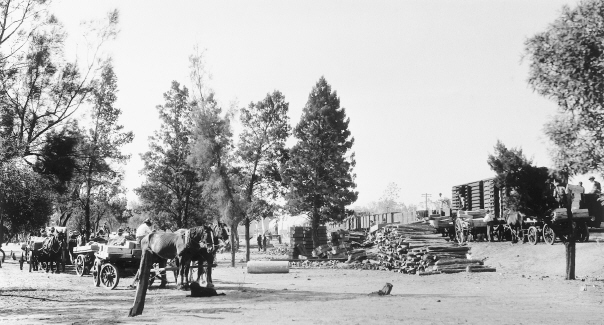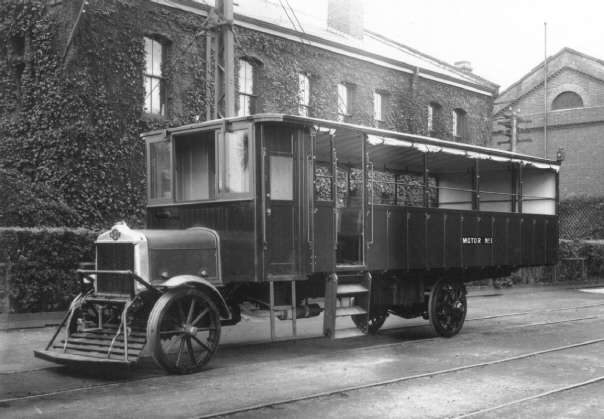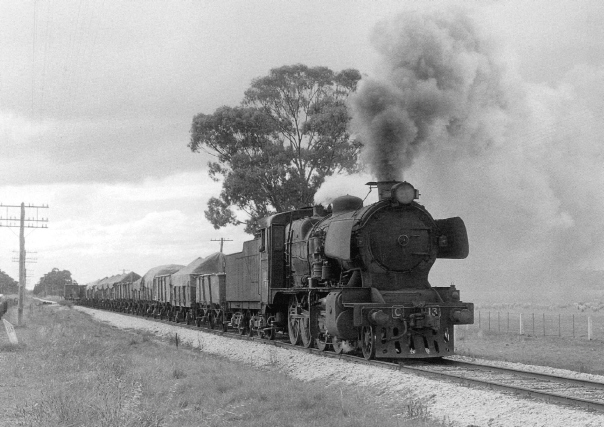
<< Back | Home | Site Map
Jack McLean (no relation to the author, but a friend for many years) wrote this article in 1978. Jack is a prominent railway historian with a special interest in railway Safeworking.
In March 1939 I purchased my first All Lines Ticket, during which I notched up 4,200 miles, which was some sort of a record at that time, but has been surpassed, by me even, since then.

First Class Fourteen Days All Stations Ticket similar to that used by Jack McLean in his adventure on the Mildura line in 1939. Source: Victorian Railways, Bruce McLean Collection
I left Spencer Street on Tuesday 14-3-1939 on the 2.40 p.m. passenger and changed at Castlemaine, where the Maryborough train preceded the Maldon AEC Rail Motor, and arrived at Maryborough at 6.28 p.m.. During the rather long and cold wait for the overnight Mildura train, I sat in the Maryborough "B" signal box and was occasionally allowed to hand up Large Electric Staffs to large engines.

The Down end of Maryborough with Signal Box "B" to the left. 6-1-1955. Photo: Des Jowett
The Mildura train was No.33; it had engine 959, a Walschaert valve-gear A2, a six-wheeled horsebox, a first class air-conditioned car, a sleeper, a second class air-conditioned car, a BW and a CE. The then current Working Time Table was, I think, the one dated 28-3-1938; in any case, there are pencilled notes in my copy which indicate that this was the copy which I carried on the journey. In it I note that No.33 was due out of Maryborough at 11.33 p.m. and my notebook shows a departure of 11.34 p.m., which was for those days a very good start. Engines were changed at Donald, 959 going off and 892 coming on. We left Donald at 1.45 a.m., only four minutes late, the new day being Wednesday 15-3-1939.
Passenger train meeting points have always been of great interest to me, and so I was awake at 1.56 a.m. when the Signal Porter turned my train into No.2 road at Litchfield, over the hand- held points. The Up should have been in the loop, but was running ten minutes late, and so my train was side-tracked instead. Strictly, my train should have gone to the platform and set back before entering the loop, as Litchfield was a definite stop, but I wonder how many passengers in a year were set down or picked up at Litchfield at that hour?
Litchfield only had switching instruments since 24-6-1939, before which it had been opened for a month or so during each wheat season. The switching hours were interesting and included "Tuesdays to Saturdays from 1.15 a.m. to 2.30 a.m.". I have often wondered what the Signal Porter did for the rest of the night!
Train No.2 was the southbound passenger, and consisted of engine A2905, a BCE (the Pinnaroo through car), a sleeper, a second class air-conditioned car, a BV and a CE. The BCE had left Pinnaroo on the Mixed at 3 p.m. the previous day, and was no doubt liberally coated with sand which adhered to the patches of oil on the bogies, and would probably still be there when the train arrived at Spencer Street.
Train No.2 arrived in time for my train to leave at 2.10 a.m., which was only ten minutes late. The stop at Birchip included refreshments, and we were there from 2.41 to 2.55 a.m., by this time 13 minutes late, Lascelles checked us at his Down Home Signal, while he put the Up goods, with engine A2 895, into No.2 road. We got away at 3.50 instead of 3.43 a.m..

In 1939 A2 locomotives were prominent on goods and passenger trains as noted in the text. In this view taken at Clunes in December 1961, some 22 years after Jack's journey, A2 947 is still working a goods train to Maryborough. Photo: Lindsay Crow, courtesy Train Hobby Publications.
Sand-wise, as we would coin a phrase some decades later, this was the worst section of the line, and it was here that I decided to call it a night, and left the BW (where there was sand on the floor, on the seats and in little hillocks on the window sills) for the comfort of the air-conditioned car. The horsebox was detached at Ouyen, where I think refreshments were available, and we stayed there from 5.03 to 5.14 a.m.. At Mildura we were two minutes early, at 6.58 a.m..
Times change, or perhaps things change as time marches on! I find it difficult now to recapture the sense of adventure in a trip to Mildura. The long Staff Section - Speed/Ouyen/Hattah/Carwarp - all of them twenty miles, the tendency to run trains at night and the stories of the dust, which at times even invaded my home at Surrey Hills, made the whole idea romantic, if that's the right word! Perhaps too, I had been influenced by Mr. Gavan-Duffy's stories, which included a comparison between the fishermen saying goodbye to their wives before sailing into the unknown, and the pre-telegraph Woomelang train crews, in 1904 say, being farewelled by their wives, who prayed to St. Christopher that the Up would run on time! And there was the story of the Station Master at Lascelles, who was supposed to have not seen a passenger train in the daylight during his three years there.
Woomelang of course, had its AEC Rail Motor, but how was the teenage thirster-for-knowledge going to inspect the line between Woomelang and Mildura? The answer was No.36 Fast Goods, which ran on Wednesdays only, so it was no coincidence that I was there in that day of the week! It was only fast, come to think of it, by the standards of those days; it took, according to the Working Time Table, 10¾ hours to run the 239¼ miles to Maryborough, which I calculate is a little over 22 miles an hour. In the event it was even slower.
D1 539 was shunting in the yard when A2 954 arrived on an unidentified Down goods, and at 9.20 a.m. No.36 departed with a louvre truck and Z572 behind engine A2 903. At Redcliffs, at 9.38 a.m., some van goods were loaded at the platform before the train was set back and brought into No.2 road. The Morkalla connection (No.2 on the branch, No.3 on the main) arrived at 10.07 behind D3 640 and, after leaving some southbound vehicles, departed for Mildura at 10.32 a.m.. The Morkalla vehicles were added to my train, together with some Redcliffs loading. It looked a little more impressive and we left Redcliffs at 10.45 a.m. which was 49 minutes late.

Redcliffs goods siding some 12 years before Jack McLean witnessed shunting of wagons off the Morkalla line onto his goods train in 1939. Photo: Wilf Henty, courtesy John Kiely
Timings for this sort of train have always been pretty elastic, and so although we stopped at Hattah at 11.53 a.m. for the Guard to act as Signalman, we were only half an hour late arriving at Ouyen. Something was wrong with the engine and it went off to the depot, but the delay enabled me to visit the Rest House, where the three-course meal (price; two shillings) was most welcome, and did a lot towards my continued interest in this incredibly interesting day. With the engine drawing second breath, we left at 1.46 p.m., 71 minutes late, and headed for the sand country. I have seen the prairies twice since then - and much prefer the prairies. I can't remember what I told Patsy Adam Smith about this trip, but it gets a mention in "Folklore of Australia's Railmen" and the repairers DID wear industrial respirators and the sand WAS so dense around Lascelles that for miles I couldn't see the engine.
At Woomelang, the engine received only routine maintenance, and we left there after 24 minutes at 3.36 p.m., 69 minutes late. Birchip was open for refreshments, and I am certain I bought at least a pie there - pies were fourpence and coffee threepence. The refreshments were, of course, really for passengers on Train No. 11 (run by AEC No.1) which fortunately was here at the same time, and if we had been on time we would have met it at Watchem.

AEC Rail Motor No. 1 before it entered service at Mildura in 1922. Motor No.1 was based at Woomelang in 1939. Photo: Victorian Railways
Also in at Birchip, in No.3 road (because my train was brought into No.2) was Train No.65, a goods, with engine A2 895 (seen last night at Lascelles), and certainly much later than we were. We should have crossed at Curyo.
When we left Birchip at 4.35 p.m., 69 minutes late, there was a changeover Guard of No.65, who quite rightly questioned my legal ability to sign my own indemnity, as I was not then quite 18. Having got over that hurdle, we got on famously, and later I shared his tea. Railway enthusiasts were still rare, and here was one he could study at leisure!
Litchfield was "switched out", but we stopped and I saw my first blazing hotbox; I 13205, for which I have searched ever since, had succumbed to the rigours of the Mallee. After the flames were under control, it was set out into No.3 road.
We were at Donald from 5.54 to 6.09 p.m., leaving there 59 minutes late with a new engine, A2 864. In the shed were A2 880 and A2 897. At St. Arnaud we waited in No.2 road from 7.04 to 7.23 p.m. for an unidentified goods train, which stormed through with C13 on the front, and at Dunolly, we were again put into the loop for No.31A goods with A2 971 on it, which we were tabled to cross at Maryborough. It was 17 late, but after waiting for it from 8.41 to 9.01 p.m., we were 86 late, and this was increased to 90 minutes by the time we reached Maryborough at 9.35 p.m.. 239¼ miles in 12¼ hours comes to about 19½ miles per hour and it had been a long day. After tea in town, and some more time in the Signal Box, I slept under the peppercorn trees opposite "B" Box until the Up passenger woke me the next morning.

Locomotive C13 near Havelock on its way to Maryborough from Donald, some 21 years after Jack McLean observed the locomotive at Dunolly. 16-7-1960. Photo: Lindsay Crow, courtesy Train Hobby Publications.
| << Back | Home | Site Map | Copyright © 2003 Bruce McLean, All Rights Reserved |